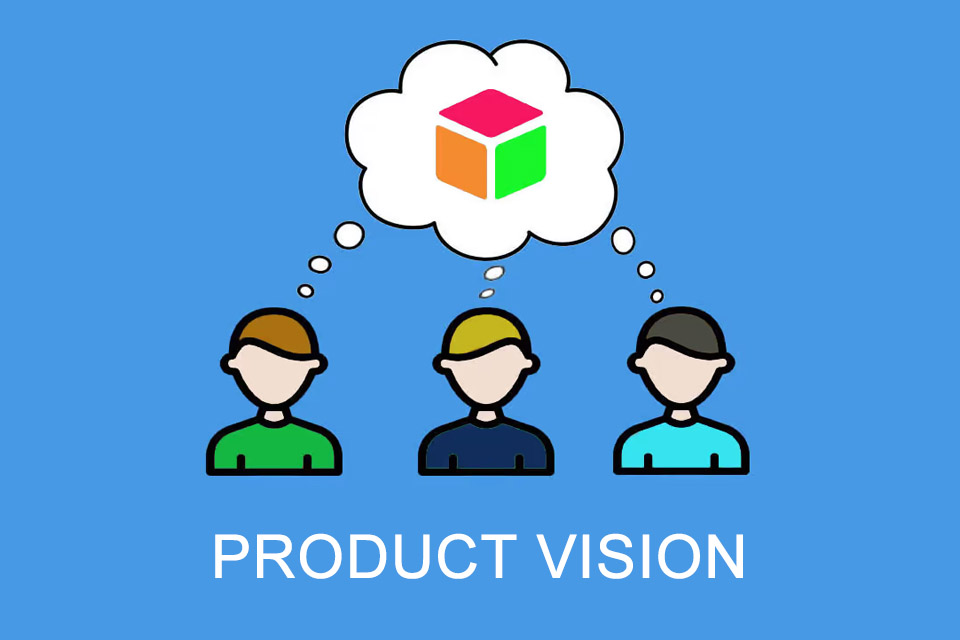What is a Product Vision?
Smartpedia: A product vision is a leitmotif and vivid outline of a product’s future, with the claim to outline the product’s long-term direction.
Product vision – the leitmotif for the development of a product
A product vision is a draft of the future that describes the purpose and intent with which a product is created. In doing so, it outlines the problems that the product will solve or the ambitions it seeks to fulfil.
The product version serves as a guiding principle for the development of a product and helps as a reference point in making decisions at different stages in the product life cycle and in providing lasting direction for all stakeholders.
- Clear and concise,
- focused on the customer,
- aligned with corporate objectives,
- future-oriented and realisable, and
- inspiring
it should describe what the product will become in the long term and what benefits it will have for its users.¹
The creation of a product vision
There are different approaches to creating a product vision.
One approach is SHIELD, for example:
- Simple: The version should be formulated concisely and simply.
- Huge: The vision should be future-oriented and reflect the potential of the product.
- Important: The importance and significance of the product should be presented.
- Engaging: The product should be engaging and inspiring.
- Long-Term: The long-term direction of the product should be outlined.
- Distributed: The vision should be visible to all stakeholders and provide lasting guidance.
Another approach is to use the Product Vision Board by Roman Pichler². Visualised as a canvas, it asks the following questions:
- What is your motivation for developing the product?
- What positive change should it bring about?
- Which market or market segment is the product aimed at?
- Who are the target customers and users?
- What problem does the product solve?
- What benefits does it offer?
- What is the product?
- What makes it stand out?
- Can the development of the product be implemented?
- What are the benefits of the product for the company?
- What are the business objectives?
Geoffrey Moore’s sentence template³ – also known as the pitch formula – provides a structure for formulating the product vision:
For [target audience] with [problem, need]³, our product delivers [solution]³, with the promise of [key feature]. Unequalled by [main competitor], it is [unique selling proposition, competitive advantage].
Steve Blank, founder of the Lean Startup movement and friend of the Minimum Viable Product approach, puts it very succinctly:
We help [target group] with [problem] with [solution].
Obviously, approaches vary widely. Which approach companies use in creating their product vision is up to them. However, it is important to fulfil the prerequisites on which a successful product vision is based:
- Detailed knowledge of the market including existing parameters, current and possibly future competitors, existing solutions with strengths and weaknesses, customer needs, if necessary classified according to enthusiasm, performance and basic factors as described by the Kano Model.
- Realistic assessment of the company’s own possibilities, capabilities and capacities. It may be worthwhile to take a look at the Effectuation approach.
- A dedicated, step-by-step approach, possibly with workshops and support from specialist departments or external service providers, in the course of which the product vision is aligned with the corporate goals and a common understanding is achieved among the stakeholders.
And last but not least, it can be important for the stakeholders to know what the differences are between a mission and a vision.
Differences between mission and vision
“I believe that this nation should commit itself to achieving the goal, before this decade is out, of landing a man on the moon and returning him safely to the earth.” John F. Kennedy, 1961
In many publications, this quotation from the former US president can be found as an example of a product vision. On closer examination, at least two points stand out:
- What is the product? “A product version is a future draft of a product…”
- Who is the target group and what is their problem or need? Typically, target groups are somewhat smaller than entire nations and presumably not very many people, even in 1961, identified the moon landing as a personal problem.
Is it perhaps more of a mission than a (product) vision? Published opinions differ as to whether a mission feeds a vision or vice versa. In lived corporate practice, both serve to define the direction of an organisation. However, they differ in their purpose:
A mission outlines the purpose of a company and thus defines a reason for the existence of the company or an undertaking. It explains what a company does for whom and provides the company’s frame of reference and aspiration for which products or services are created. Often the mission is directed outwards towards the market or customers.
A vision is a statement of what the company wants to become and how it will benefit its customers and stakeholders with said products or services. “For [target audience] with [problem, need], our product delivers [solution], with the promise that [key feature].” In some ways, the vision – especially when created using the SHIELD criteria, Roman Pichler’s questions or Geoffrey Moore’s sentence template – is more specific. It is also often internally focused and provides guidance as an element of product development.
Remark: The Objectives and Key Results (OKR) Framework distinguishes the two terms as follows:
- A mission is the enduring and long-term task that justifies the existence of the organisation or a product.
- A vision is an ambitious and clear picture of the future that describes where the organisation or a product wants to be in the next few years.
Advantages of product visions
There are several advantages to using a product vision:
- It helps to align the product team and stakeholders towards a common goal and ensures that everyone is working towards the same outcome.
- It provides orientation for the development or further development of the product, helps define a roadmap and is a useful counterweight against, for example, bloatware.
- It serves as a basis for decision-making and prioritisation and helps the product team to focus on the most important features and characteristics.
- It can inspire and motivate the product team and provide a sense of purpose and direction.
- It can be used to communicate the value and benefits of the product to stakeholders, i.e. interest groups, investors or customers.
- It helps position the product in the market and understand how it can differentiate itself from the competition.
And: a product vision helps to think long-term and plan how the product can evolve and adapt over time.
Tips for creating a product vision
There are some tips for creating a product vision:
You probably work in an organisation that offers products or services. If your organisation works with product visions, can you name one? If not, it could be because it was formulated too awkwardly, ambiguously or with too many words. Tip 1 is therefore: formulate your product vision simply and concisely. And communicate the content again and again among the stakeholders involved so that everyone understands and agrees with it.
For whom and for what need or problem is your organisation developing products or services? Tip 2: Put the focus on customers and users!
It is good when organisations focus on their customers. It is even better if these customers are actively heard by companies. Tip 3: Seek the views of stakeholders, customers and other key participants while creating the vision.
Product development is often characterised by short-termism, new requirements or changing parameters. Tip 4: Create a product vision that provides long-term orientation and functions as a guiding principle, because this permanently facilitates the prioritisation of features, the making of decisions and the cooperation in the team.
There are many ideas and desires that could be addressed through products or services. However, as a company, it makes sense to address these ideas and desires strategically. Tip 5: Align the product vision with the overall corporate strategy and goals, supporting the mission and values of the company.
Impulse to discuss
“A computer on every desk and in every home.” formulated Bill Gates in 1975. Is that more of a mission or a vision statement?
Notes:
[1] The product version should also be flexible enough to change as markets, technologies or competition change.
[2] The Product Vision Board by Roman Pichler
[3] Geoffrey Moore: Crossing the Chasm
Here you will find a delineation of market goal, product goal and product vision.
If you like the article or would like to discuss it, please feel free to share it in your network. And if you have any comments, please do not hesitate to send us a message.
And here you will find additional information from our t2informatik Blog:



